| | Review: Dboys Full Metal M4A1 Author: Zachattack Table of contents Real steel history Ordering First Impressions Feel Accessories Performance Externals Internals Pictures with my jg guns Pros and cons Conclusion Real steel history The M4 is a shortened version of the M16A2. According to different sources it is between 80-85% interchangeable with the M16A2. The only diffrences in the M16A2 and the M4 is the barrel length and the stock is adjustable. In the US military it replaced the M9 pistol, the M3A1 smg, and a few M16A2's. At first it seemed like the perfect weapon, but it has it's problems. Due to the 5.56mm round and the shortened barrel it muzzle velocity is lower than the m16's and it's range is decreased by a significant amount. The differences between the M4 and the M4A1 are these. The M4 has a semi and three round burst option, while the m4a1 has a semi and a full auto option. And the M4 has a fixed carry handle while the M4A1 has a removable one. Sites used to research the real steel article are www.baseops.net www.world.guns.ru Ordering I ordered this gun from pointact.com. I ordered it on a Monday night and had it Thursday afternoon. I would recommend pointact to anyone. I've ordered from them twice and they have exceptional CS. The reason I got this gun was because I wanted the metal body from it for my m16 and this seemed like the best way to get it. Shipping for this item will be around $11.50 to the lower 48 states. 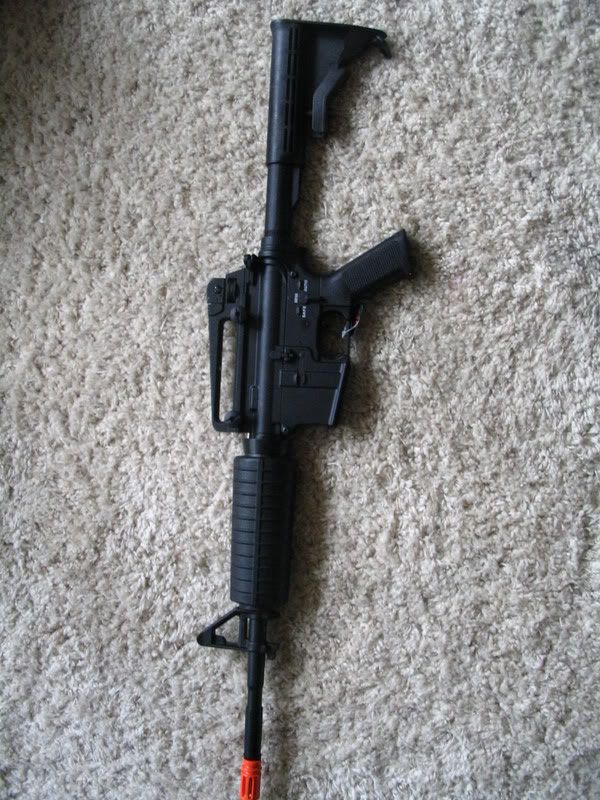 First Impressions I opened up the package and the box had no plastic wrap on it, but it had two thick plastic straps around it. I cut those and pulled the cover off. Everything was shuffled around in the box. No big worries. I actually sort of expected that. When I picked up the gun it was, as expected, heavier than a plastic body m4. It's about as heavy as my jg m16.  Feel This guns feel is awesome. The cold metal touching your hand along with the dboys nylon is a great feeling. The gun is weighted correctly and doesn't feel lopsided either frontwards or backwards while carrying it. This gun is as solid as a rock. Next to my jg m733 this gun feels a lot nicer. The metal seems to be of decent (good clone quality) quality on this gun. Accessories It comes with a standard wall charger, a battery, allen wrench, philips screwdriver, small bag of bb's, a 3 point sling, that feels to be of very good quality, unjamming rod, and of course the gun. The only thing that really can be put on this m4, as it is, is a scope or rds. Performance This gun is a great performer. I would recommend it for a beginner. Stock it is very accurate, and the fps is in the low 300's. (Not chronoed, but it goes through one side of a coke can) Not too much for a beginner. At 120ft measured I can hit a tree, that's about 3/4 the width of a man, nine times out of ten. One of this guns plusses is that it is very quiet, which I like a lot. It is the quietest clone that I've heard. It's not as quiet or as smooth sounding as a TM, but it definitely not a gun that sounds like it is under a lot of stress. It's rate of fire seems a little slower than other clones. I've heard this was caused by the motor. I haven't tested though. Externals  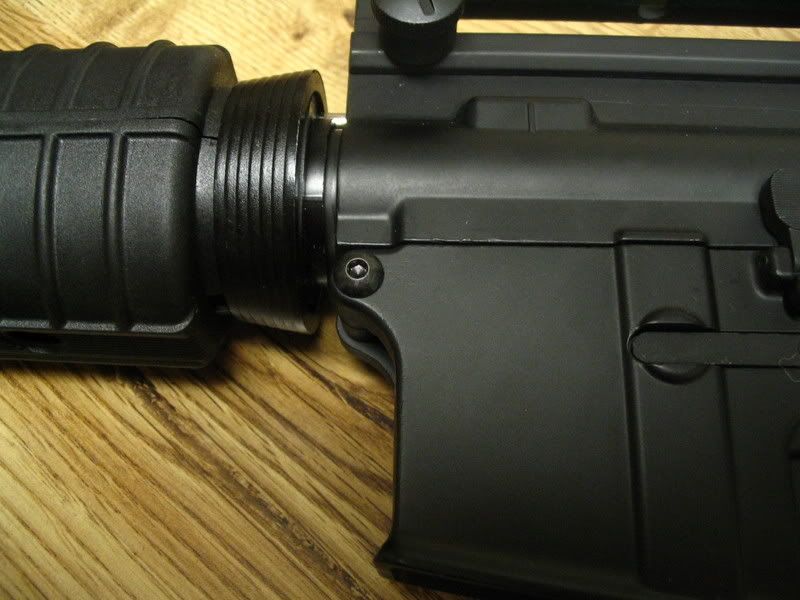  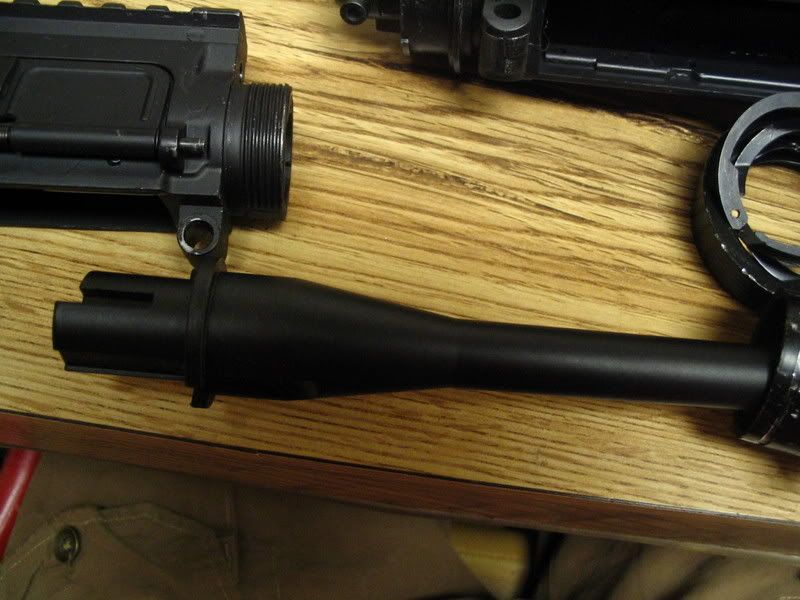 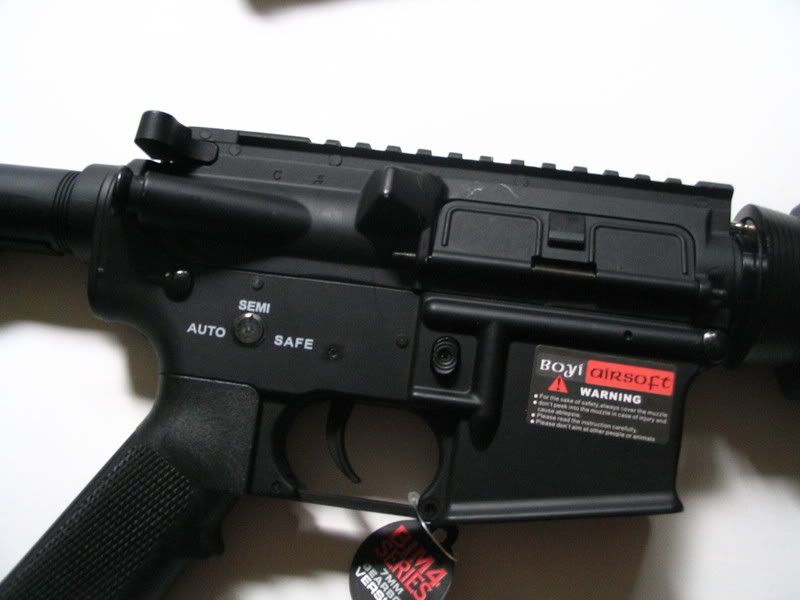 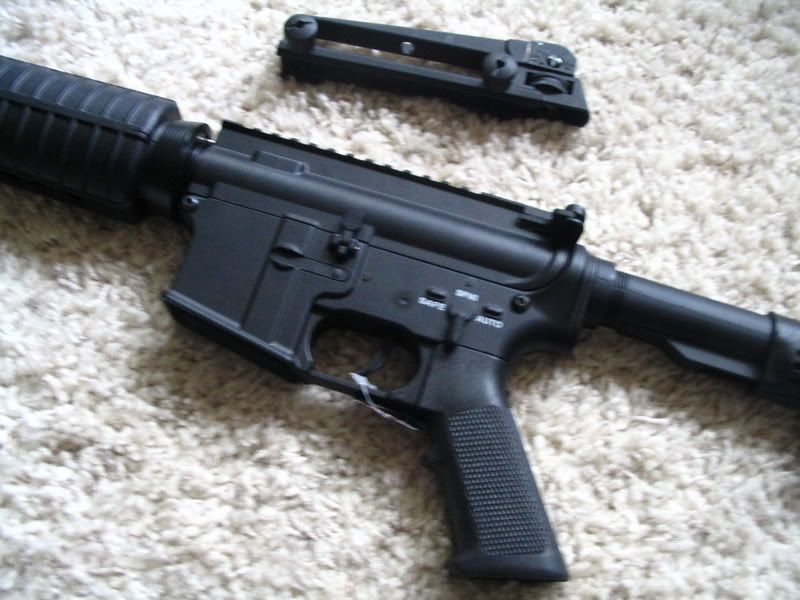 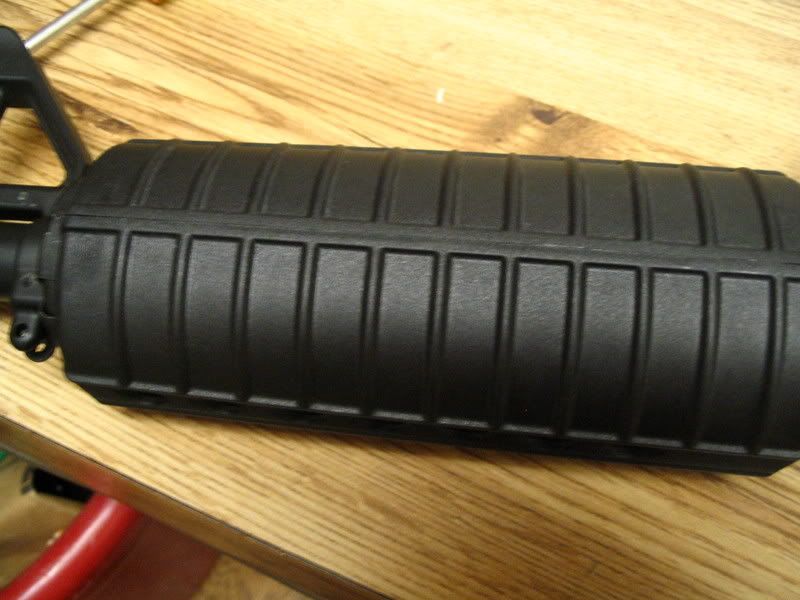 The externals of this gun are really good. Everything but the handgrips, pistol grip, and sliding stock is metal. Those parts are made out of dboys nylon that feels really nice. I prefer it to abs plastic. The outer barrel is a one piece, so that's a nice bonus. I couldn't get the barrel to shorten as the plastic body version can do though. A different person got theirs to shorten though so I must not have been twisting it hard enough. The flash hider is painted orange and is a 14mm CCW. The metal on the gun is fairly good. I've heard reports that it's pot metal, but it doesn't seem like it to me. Mine doesn't nick or scratch that easily. I would definitely recommend it above a plastic body. One of it's bad parts is that the magwell is a little too big. The mag it comes with is a little loose and my jg mags don't even work in it. However I put some one sided stick felt pads (skinniest ones I could find) in there and now the mag doesn't rattle around, but I still can't get my jg mags to work. They won't clip into place. Edit 9/22/07 The front pin that holds the upper receiver to the lower receiver is really tight on a lot of dboys metal body guns from what I've heard. Mine was this way so I took a look at the problem. The problem isn't the pin being to big or the holes it goes into being too small. The problem is that the lower receiver holes aren't lined up correctly. This makes the bolt have to go in a little bit sideways. The was to fix it is just to dremel a little bit off of the top of one side and a little bit off of the bottom of the other side. Edit 8/31/07 I found out the reason why jg mags don't work. The little plastic piece that holds the bb's from squirting out is a little too long. If you shave a little bit off it can still hold the bb's in and work in this gun. Another problem with this gun is that the top rail is too skinny. It won't let a rail mount mount properly. Internals  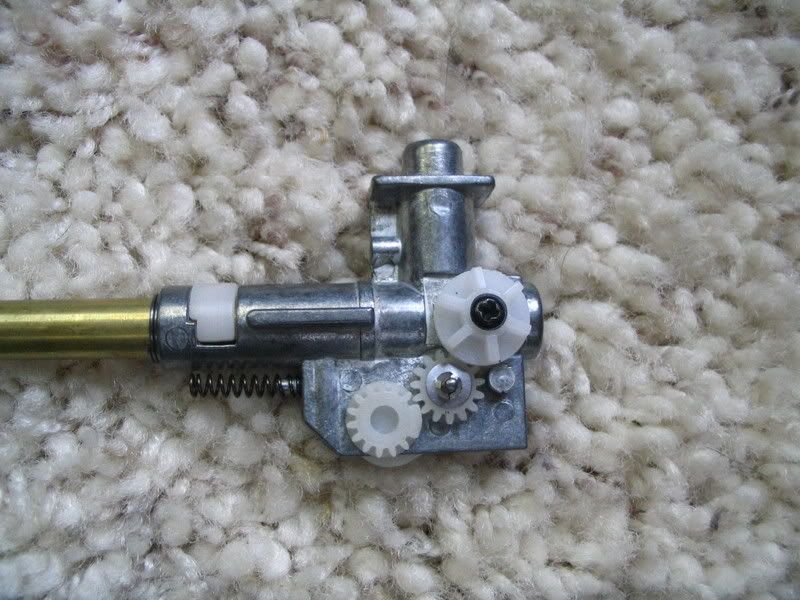 First the hop up. The hop up is a one piece metal hop up that is really consistent. Very few shots are fliers compared to my jg's hop up which sends one crazy about one in every ten shots. The stock hop up rubber could use replacing though. It's too hard to be really effective. The inner barrel is a brass barrel. It looks to be decent. At least it's not aluminum. 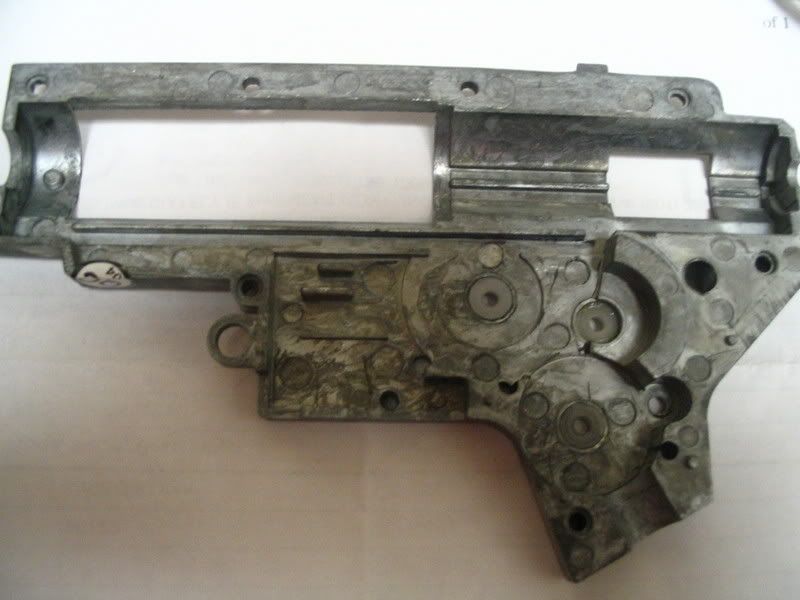 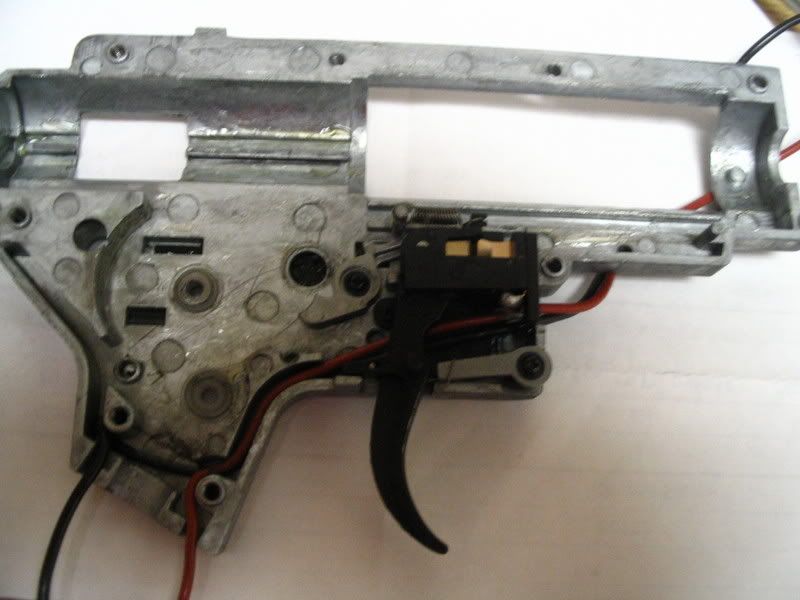 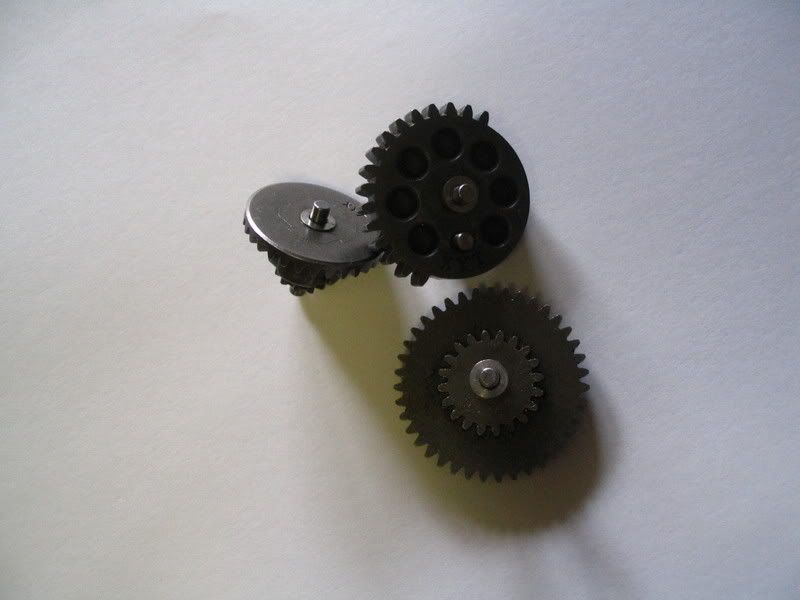 The gearbox shell is a reinforced one, and the gears are standard xyt gears. 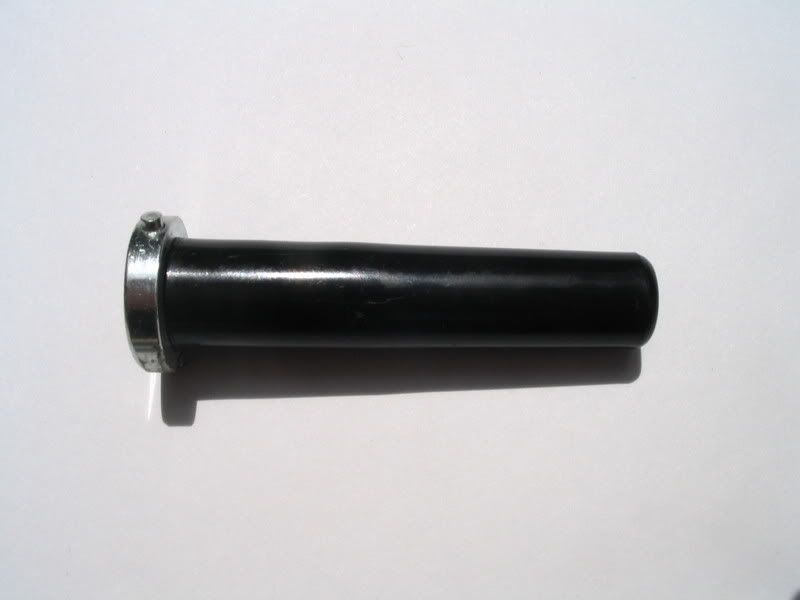 The spring guide is plastic with a metal base.  The piston looks like a reinforced one, while the piston head looks like a normal ported acm one. It has 6 holes. 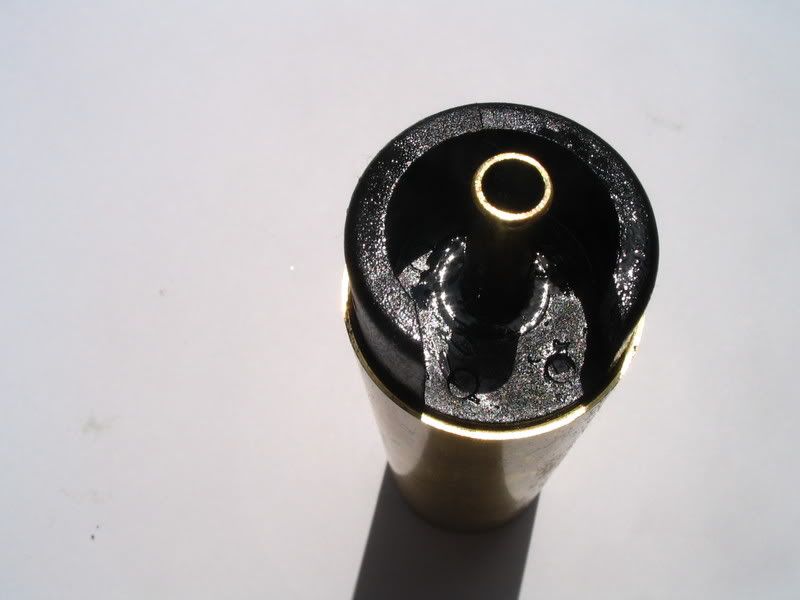 The cylinder is a type 0 cylinder and the compression was horrible until I changed the o ring on the piston head to a new #14 o ring. After that the compression was great. I didn't put any teflon tape on the cylinder head. That had a good seal. 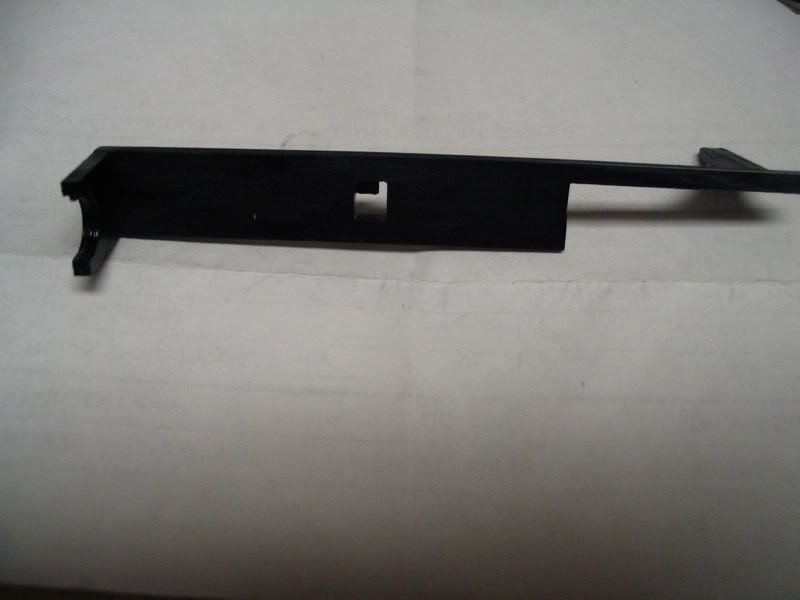 The tappet plate's plastic is of high quality. It seems like it could stand a lot of bending before it would break. 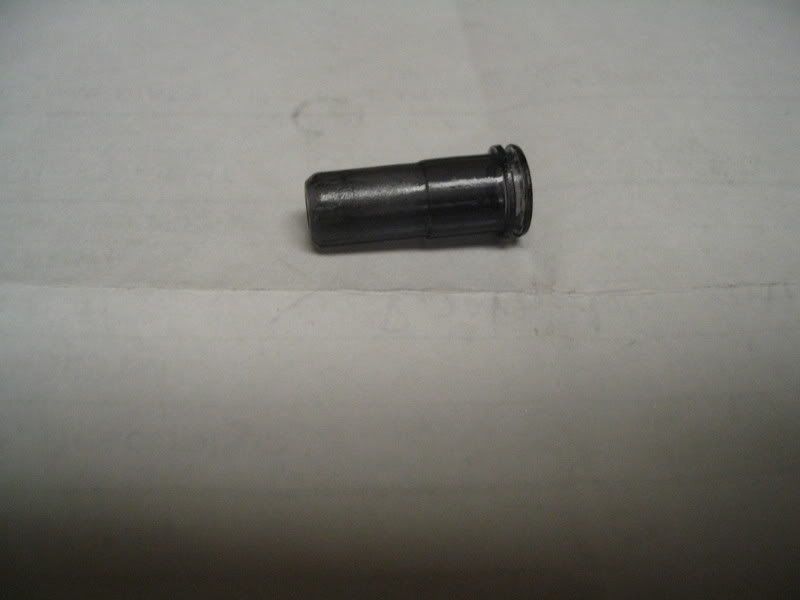 Air nozzle I've never seen a clear gray one before. Kind of odd. The cyma ones are/were clear, but not a see through color. The shimming wasn't very good. Just one shim on each side of every gear. This let the gears spin fairly well though, so if you don't know how to open up a gearbox it isn't totally necessary to re-shim it. The wiring doesn't look the greatest either. It looks like 18 awg. A little small imho. It has a fuse that is strapped to the outer barrel under the foregrip. I read a review that said the wiring looked bad, but in reality it was ok and the motor just wasn’t good enough to give it a good rate of fire. The gearbox has very little grease in it. If you get this gun and can work on gearboxes a regrease, shim job, and a new o ring are the best things you can do. Pictures of it with my jg guns  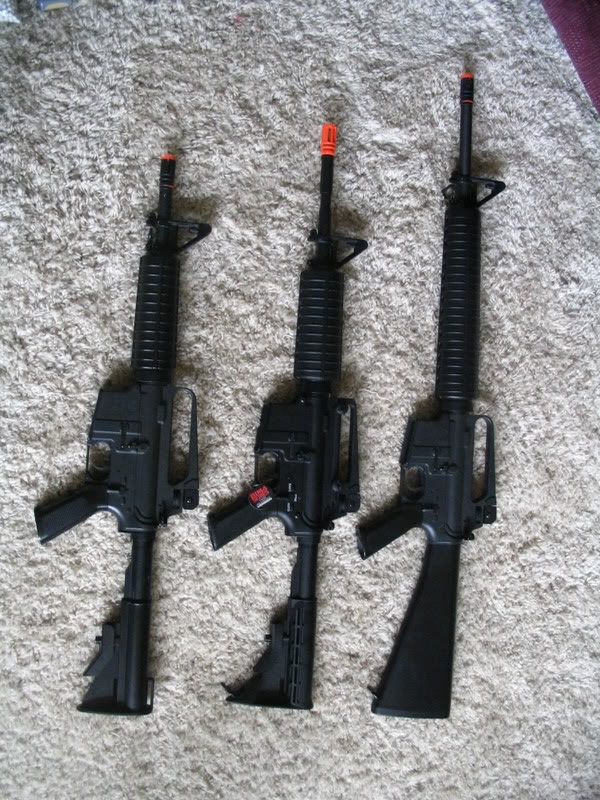 Dboys in the middle. Jg guns on top and bottom of it. Pros Full metal Metal hop up that's consistent 7mm reinforced gearbox shell Brass inner barrel Great stock accuracy Quiet for a clone Price Cons Upper and lower reciever have a very little space in between them Stock wobbles a little bit Magwell is a little too big and mags rattle around in there. My jg mags don't even work in it. Shimming could be better Conclusion In conclusion this is a very good gun for the price. It is just an outstanding clone. For just $130 you get a full metal gun that is very accurate. It's fps isn't to high to use for cqb and it's not so low it can't be used for woodland. There is nothing on this gun that needs immediate attention which makes it a good gun for beginners. But of course like all clones there are things you can do to make it better. |
Friday, April 30, 2010
Dboys Full Metal M4A1
Review: WE M1911 .45 Tactical Model
Introduction:
The classic 1911, a product developed from the genius John Browning almost 100 years ago. Although the M1911 series has been replaced by the Beretta M9 in the US military in the late 80s, the venerable 1911 models are still being used by Law Enforcement personnel, by the Special operations segment of the military (including special missions units), and by exhibitions shooters all across America. Furthermore, it has found itself in the homes of many civilians as a self-defense gun and as a recreational pistol for occasional plinking.
Because I rarely use my sidearm in skirmishes, I made the decision to get a KJW M9 (plastic edition GBB) two years ago because of its low price. In my last skirmish, my primary gun (M4A1) failed to work in a middle of a 'firefight' (loose wiring) and I was forced to pull out my trusty M9 during the engagement. It was then I truly appreciated the usefulness of GBB pistols. However, after 2 years of use with green gas, the outer barrel and the slide is cracked from the strain of the blowback action. At this point, I decided to invest in a full metal GBB pistol. Since full metal GBBs normally run over $100 (pricey for a sidearm that rarely gets used as much), I wanted something that was a great performer and was realistic in terms of weight. Realism and weight was an issue for me, as I am an avid real steel firearms shooter (I've been 'spoiled' by real steel for a while now). Instead of going for a 9mm handgun, I had my sights set on 1911 styled handgun. A few of my buddies own real steel Kimbers and Springfields…and I was impressed with them. I knew for certain I didn't want a 1911 "Race gun" because I wanted retain the tactical look for my loadout. I looked into WE 1911s because they were the most reasonably priced full metal 1911s in the markets at the moment. Likewise, the WE 1911s at Airsoftgi comes with 2 magazines instead of 1. I initially looked at the Government model 1911A1, but decided to get the "tactical" version for $5 more at a price of $109. The tactical version featured an updated/modernized frame (that contains a rail system) and slide. The tactical version is loosely based off various Para-Ordinance's/Springfield's/Wilson's/Kimber's/S&W's 1911s.
First Impressions:
The entire package came one whole day earlier than scheduled. Along with the compact, but hefty WE box, AirsoftGi was nice enough to give me one of their ballcaps as well.
The box is cardboard with a large "WE" in front. Likewise, AirsoftGi advertises this 1911 as the "latest" version of this model in their inventory.
Upon opening the box, I was surprised at how it was packaged. The black cloth that covered the foam packaging was an excellent touch, a steep comparison to my old KJW packaging with white the blatant white Styrofoam.
As I reached for the 1911, I was sincerely hoping the weight would be 'realistic' enough to my liking. Fortunately, I was not disappointed as the pistol is quite solid and well weighted (even more so with the magazine inserted).
The finish appears to be parkarized with a satin black finish. The finish is very smooth without any imperfections. The magazines also have the same finish. The slide has a reasonable hefty 'clink' when the slide is pulled back. The action seemed to be quite crisp compared to my plastic M9 GBB.
Closer look:
The outer barrel is chrome. WE did an excellent job replicating the rifling and grooves inside the faux outer barrel. Likewise, a portion of the barrel sitting in the chamber area has .45 ACP engraved in it.
The slide is sharply made and detailed. The diagonal grooved strips on the front and rear of the slide is also sharply engraved, allowing the operator for better gripping when pulling the slide back.
Another reason I picked the tactical model over the government one is because the rear sights are adjustable. They are also painted with white dots to facilitate with lining up the iron sights when aiming. However, there is a little play in movement with the rear iron sights. It could be that it just needs to be tightened on my part, but the movement's not so large to cause accuracy problems. There are no engraved trademarks anywhere…not even a "Made In Taiwan" statement (that came as a golden sticker on the slide). Therefore, there are no fake trades either that would signify it as an airsoft pistol on the slide.
The bottom frame features an integrated Picatinny rail system that allows for the quick attachment for various lasers and lights. This is another reason why I purchased this model over the government model. The front and rear of the grips are also engraved with a minutely and intricate checker pattern to facilitate with better gripping. On the trigger guard, there is a very small engraved "WE" inside a circle, the only engraved text you'll find on this gun.
The grip safety is functional and differs from the government 1911's shape, as it is longer and curls upward to protect the operator's hand from the hammer and the slide when it blows back. The thumb safety is also ambidextrous and longer, unlike the government model.
Field stripping is relatively simple. Pull back the slide until slide catch end reaches the designated groove and push out the slide catch. The slide then slides off. Unlike my KJW M9, the hop-up is adjustable. To access the hop-up, the slide needs to be taken off. The hop-up is adjusted via the black dial.
The magazines are very detailed and well made as well. They come in the same finish as the slide and frame. The magazines are single stacked and hold 15 rounds. Complaints I've heard about the magazines are that they 'cool' down very very quickly with rapid fire shots. However, upon doing double taps, I was still able to fire all 15 rounds off…although the last several shots started dropping in velocity.
A full charge of gas (~14 seconds or so) is enough to empty all 15 rounds in the magazine.
Another feature worth noting is that the magazine is quite easy to load. The magazine feeding spring can be locked to the bottom (like KWC's Witness .45 springer magazines). There is a circular hole in the bottom front of the magazine where the user can pour in or out the rounds. This is much quicker than stacking the rounds on the top of the magazine. Likewise, this also helps minimize wear done to the plastic feeding guide on the top of magazine.
 If you look you can see the hole in the front, bottom half of the magazine.
If you look you can see the hole in the front, bottom half of the magazine.
Performance:
I don't have a chronograph, but the gun is advertised to shoot from 300-330 FPS on Green gas.
The blow back is very crisp and the gun itself is quite accurate at 60 feet as well.
With the Coke can test, the 1911 was able to pierce through both sides of the can. It was not able to pierce the bottom of the can. According to Redwolf Airsoft, this is about 350-370 fps.
http://www.redwolfairsoft.com/redwolf/airsoft/BulletDetail?bulletID=34
The 1911 was able to cleanly penetrate both sides of the Dr. Pepper can.

Entry hole
Exit hole
Even though I don't have a picture of the bottom of the can, the bottom of the can was not penetrated.
Compared to my KJW M9, this 1911 shoots with better accuracy and at a higher velocity. The hop-up is quite responsive. I have not used this in a skirmish, but it I was able to hit human size targets at around 80 ft away. It is important to remember that this GBB should be used as a defense gun, rather than an offensive gun. With that in mind, engagements with this secondary should usually be under 120 ft or so. Common sense would dictate that anything beyond that range would require a rifle. The blowback itself is crisp and contains more 'whump' than my plastic M9. I would say the recoil feeling is similar to a .22 handgun with a heavy bull barrel. But it has the same amount of recoil as a real Ruger MKII with an integrated suppressor. For the super realists out there, don't expect the same amount of recoil you normally get with a real 1911, as it's just not possible with an airsoft replica at this time.
Accuracy:
Tests were conducted from 30 ft, 50 ft, and 70 ft. There was a slight breeze of 4 mph. I was shooting standing and unsupported.
The targets are printed on a standard 8.5" x 11" sheet. The logic is, if you can hit this size of paper, you can hit a human torso. The entire target circle has a diameter of 5.5". As for the ammo I was using, I was using your typical white .20 g BBs.
At 30 ft, the grouping is consistantly in the black area of the target. This is a fairly close range for an engagement. This range would probably represent some indoor CQC.
At 50 ft, the accuracy has dropped, but I was still able to get consistent shots in the target in general.
For the NRA .22 handgun competitive shooting, 50 ft is the standard range for the shot. Although the GBB 1911 is no where consistent in grouping as real steel, the grouping here is quite impressive for an airsoft gun when firing standing and unsupported.
At 70 ft, this range is pushing the accuracy of most GBB guns. I was still able to hit the target, but most of the shots went around it on the paper, and a few missed the sheet completely. Considering the projectile is round and not conical, this is acceptable.
This gun is quite accurate with single shots. It still is fairly accurate with double taps. Depending on how much gas you charge in each magazines, the user will notice a drop in FPS in the last several shots. Likewise, accuracy is also partially dependent on how much the user adjusted the Hop UP.
Problems/Issues:
The magazine does cool down (inherit problem with gas guns in general) with rapid shots. However, with controlled double taps, the cooling issue is negligible. When I first pulled back the slide (before firing), the gun itself was very dry (as in not quite lubed). After lubing the barrel/chamber, trigger and hammer area, the cycling operations was much smoother. I also lubed both magazines (the parts where gas is injected/expelled). I recommend you lubricate these parts with silicone oil before firing the 1911. Another quirk I have with this gun is the lack of trademarks on it, but it's not at all critical during field use. Even though spring is strong enough for crisp action for the slide, it's still feels slightly sluggish compared to real steel pistols, but still much more crisp than my old KJW M9.
Another problem some people are aware of with this particular model is the finicky slide lock. There have been reports that the slide doesn't always lock back with each shot. After several days of testing and experimenting with different scenarios, I found this problem only occurs when there isn't much gas left in the magazine. The gun will still cycle, but there isn't enough blow back for the slide go back far or hard enough for the slide lock to engage it. The vibration from the recoil combined with a small piece on the magazine helps pushes the slide catch upwards. Without the 'recoil' from a strong blow back action, the slide will not lock back. The rounds will still be fired at this point, but there is a drop in FPS. One way to counter this is to charge enough gas into the magazine (about 14 seconds or so). This number may be tentative for each individual magazine, but the 1911 tends to perform better on this trend. Likewise, if you're going to charge that much gas into the magazines, remember to lubricate the magazines (the o-rings) often.
The black plastic grips look fairly cheap, but are not 'cheap-cheap' plastic you'll find on Chinese guns. But for such a nice replica, the grips detract from the overall look and feel of the gun.
Modification:
Since I had a KWC Witness 1911 springer with faux wood grips that I painted before, I decided to slap them on the WE 1911 to give it more character. The grips will not fit without modification. Modification includes widening the screw holes and shaving excess areas so the right side safety will fit. I then also painted the stock grips with a Khaki/Mimosa color followed with a black and brown wash to give it the Kimber styled MARSOC 1911 Warrior look.

With my old KWC Witness 1911 'wood' grips. The grips were painted by me for a more realistic look.
While not considered a real modification, the rail can take on lights and lasers as well.
Once a light is slapped on a 1911, normal holsters will usually not be able to take it, as the 1911 is too bulky for it. I also had to modify my old, dirt cheap holster for it to take the 1911 with light.

The painted grips give the gun better contrast while seated in the holster.
Conclusion:
Overall, for the price, this 1911 is an excellent purchase. Western Arms 1911 are double the price and have plastic slides. In conclusion, I was fairly surprised at quality of this gun, and this gun has far exceeded my expectations.
Pros:
- Full metal at a reasonable price in the current market for 1911s
- Adjustable sights
- Rail system for accessory attachments
- Good blowback
- Sharp details and nice, smooth finish
- Good accuracy for a pistol
- Realistic weight and quite solid
- Came with 2 magazines (at AirsoftGI)
- Uniqueness in that it's not another 'Glock' or 'USP'
- Works well for those MARSOC Force Recon or US Army SF load-outs.
Cons:
- Ugly, cheap looking plastic black grips
- Magazine cooling down if you 'machine-gun' the 1911
- Rear sights wiggle slightly, but it can be tightened
- Grip safety slightly wobbles, but not too critical.
- Lack of trademarks of any sort.
- The gun comes "dry," so lubing is highly recommended before first use.
- Finicky slide lock when not much gas left in the magazine for the it to engage the slide.
Score:
- Looks: 9.0/10
- Feel: 9.0/10
- Performance: 8.5/10
- Potential: 9.0/10
Overall: 9.0/10
Verdict: Highly recommended if you're a pistol enthusiast and or if you want a good secondary sidearm.
- Share this on del.icio.us
- Digg this!
- Stumble upon something good? Share it on StumbleUpon
- Share this on Reddit
- Add this to Google Bookmarks
- Tweet This!
- Share this on Facebook
- Share this on Mixx
- Subscribe
- Buzz up!
- Share this on Linkedin
- Submit this to DesignFloat
- Share this on Technorati
- Submit this to Script & Style
- Post this to MySpace
- Share this on Blinklist
- Share this on FriendFeed
- Seed this on Newsvine
Review: Bell M1911A1 Full-Metal GBB (EG723) Dennis Wells
- Share this on del.icio.us
- Digg this!
- Stumble upon something good? Share it on StumbleUpon
- Share this on Reddit
- Add this to Google Bookmarks
- Tweet This!
- Share this on Facebook
- Share this on Mixx
- Subscribe
- Buzz up!
- Share this on Linkedin
- Submit this to DesignFloat
- Share this on Technorati
- Submit this to Script & Style
- Post this to MySpace
- Share this on Blinklist
- Share this on FriendFeed
- Seed this on Newsvine







































